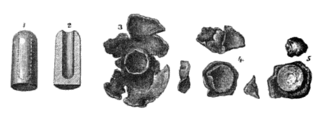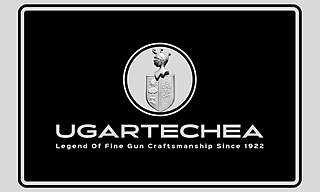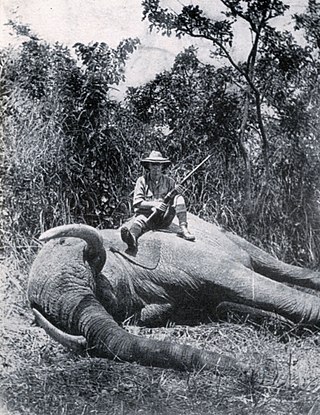
Webley & Scott is an arms manufacturer founded in Birmingham, England. Webley produced handguns and long guns from 1834 to 1979, when the company ceased to manufacture firearms and instead turned its attention to producing air pistols and air rifles. In 2010 Webley & Scott restarted the production of shotguns for commercial sale.
Holland & Holland is a British gunmaker and clothing retailer based in London, England, which offers handmade sporting rifles and shotguns. The company holds two royal warrants.

The term express was first applied to hunting rifles and ammunition beginning in the mid-19th century, to indicate a rifle or ammunition capable of higher than typical velocities. The early express cartridges used a heavy charge of black powder to propel a lightweight, often hollow point bullet, at high velocities to maximize point blank range. Later the express cartridges were loaded with nitrocellulose-based gunpowder, leading to the Nitro Express cartridges, the first of which was the .450 Nitro Express.

The double rifle, also known as a double-barreled rifle, is a rifle with two barrels mounted parallel to each other that can be fired simultaneously or sequentially in quick succession. Synonymous with big game hunting found primarily in Africa and Asia, the double rifle is a sporting weapon with very little military heritage.
The .416 Rigby is a rifle cartridge designed in 1911 by London based gunmaker John Rigby & Company, for hunting dangerous game. It is the first cartridge to use a bullet of .416 inch diameter. The rifles, as built by John Rigby & Co., were initially made up on the Magnum Mauser 98 action, although in later years, some were made on standard length actions, a perfect example being the rifle used by legendary professional hunter Harry Selby. Other famous users of the cartridge were Commander David Enderby Blunt, John Taylor, and Jack O'Connor.

The Nitro Express (NE) series of cartridges are used in large-bore hunting rifles, also known as elephant guns or express rifles, but later came to include smaller bore high velocity British cartridges.
The .600 Nitro Express is a large bore Nitro Express rifle cartridge developed by W.J. Jeffery & Co for the purpose of hunting large game such as elephant.
The .577 Nitro Express is a large-bore centerfire rifle cartridge designed for the purpose of hunting large game such as elephant. This cartridge is used almost exclusively in single-shot and double express rifles for hunting in the Tropics or hot climates in general and is a cartridge associated with the golden age of African safaris and Indian shikars.
Westley Richards is a British manufacturer of guns and rifles and also a well established gunsmith. The company was founded in 1812 by William Westley Richards, who was responsible for the early innovation of many rifles used in wars featuring the British Army during the 1800s. It remained in the hands of the Richards family until it was purchased by Walter Clode in 1957. Currently the company has two listed directors, Alexander Clode and Sheikh Sultan Bin Jassim Al Thani of Qatar. The company has received a number of royal warrants since 1840.
.450 Nitro Express also known as the .450 Nitro Express 31⁄4-inch is a rifle cartridge designed for hunting dangerous game such as elephant, rhino, cape buffalo, lion, and leopard. This cartridge is used almost exclusively in double rifles for hunting in the Tropics or hot climates in general and is associated with the Golden Age of African safaris and Indian shikars.
The Lloyd Rifle was the 1950s brainchild of English deer-stalker, rifleman, metallurgist and engineer David Llewellyn Lloyd. His objective was to create a high-quality, scope-sighted, magazine-fed sporting rifle capable of dependably high accuracy at long ranges, of retaining its zero despite rough handling, and of firing modern high-intensity, flat shooting cartridges such as the .244 H&H Magnum and the .264 Winchester Magnum.

John Rigby & Company is a gunmaking firm founded by John Rigby in 1775 in Dublin. The company was established by the first John Rigby in Dublin, Ireland, apparently in 1775; his grandson, also John, opened a London branch in 1865; and Dublin operations had ceased by February 1897. The company is now owned by Lüke & Ortmeier Gruppe and is based in Vauxhall, central London, under the supervision of managing director, Marc Newton.

Armas Ugartechea is a Basque Spanish manufacturer of guns and rifles located in Eibar, is a privately held Spanish firearms manufacturing company. Its firearms are used worldwide for a variety of sporting and hunting purposes. It produces several models of double-barreled shotgun. It is devoted to the craft manufacturing of fine hunting shotguns and is the heir of a long craftsman tradition that has cleverly incorporated new technologies in the production of its guns, and, at the same time, keeping its traditional know how. It was the first Spanish company to start making under and over barrel guns. I. Ugartechea is well known for the quality of its work both at home and abroad. Is one of the few gunmakers to produce its own barrels, flawless at best. A present, Armas Ugartechea sells its guns worldwide. Among its customers are heads of state and monarchs from several countries, as well as top hunters and crack shots. The Ugartechea Family is still in charge of the company which is a basic principle, as they are the ones who know better how to optimize the manufacture of these firearms, which combine with craftsman work the best technology.

The .404 Jeffery is a rifle cartridge designed for hunting large, dangerous game animals, such as the "Big Five" of Africa. The cartridge is standardized by the C.I.P. and is also known as .404 Rimless Nitro Express. It was designed in 1905 by London based gunmaker W.J. Jeffery & Co to duplicate the performance of the .450/400 Nitro Express 3-inch in bolt-action rifles. The .404 Jeffery fired a bullet of .422 in (10.72 mm) diameter of either 300 gr (19 g) with a muzzle velocity of 2,600 ft/s (790 m/s) and muzzle energy of 4,500 foot-pounds force (6,100 N⋅m) or 400 gr (26 g) with a muzzle velocity of 2,150 ft/s (660 m/s) and 4,100 foot-pounds force (5,600 N⋅m) of energy. It is very effective on large game and is favored by many hunters of dangerous game. The .404 Jeffery was popular with hunters and game wardens in Africa because of its good performance with manageable recoil. By way of comparison, the .416 Rigby and .416 Remington Magnum cartridges fire .416 in (10.57 mm) bullets of 400 gr at 2,400 feet per second (730 m/s) with a muzzle energy of approximately 5,000 foot-pounds force (6,800 N⋅m). These cartridges exceed the ballistic performance of the .404 Jeffery but at the price of greater recoil and, in the case of the .416 Rigby, rifles that are more expensive.
The .400 Jeffery Nitro Express or .450/400 Nitro Express 3-inch is a medium bore, bottlenecked, Nitro Express cartridge designed by W.J. Jeffery & Co in 1902, intended for use in single shot and double rifles.
The .333 Jeffery and .333 Jeffery Flanged are medium-bore rifle cartridges developed by W.J. Jeffery & Co and introduced in 1908.

The .318 Westley Richards, also known as the .318 Rimless Nitro Express and the .318 Accelerated Express, is a proprietary medium bore centerfire rifle cartridge developed by Westley Richards.
The .400/360 Nitro Express cartridges are a number of very similar, but not interchangeable, centerfire rifle cartridges developed by James Purdey & Sons, William Evans, Westley Richards and Fraser of Edinburgh, all at the beginning of the 20th century.

James H. "Jim" Sutherland was a Scottish-born soldier and professional hunter, who shot between 1,300 and 1,600 elephants in his life.









